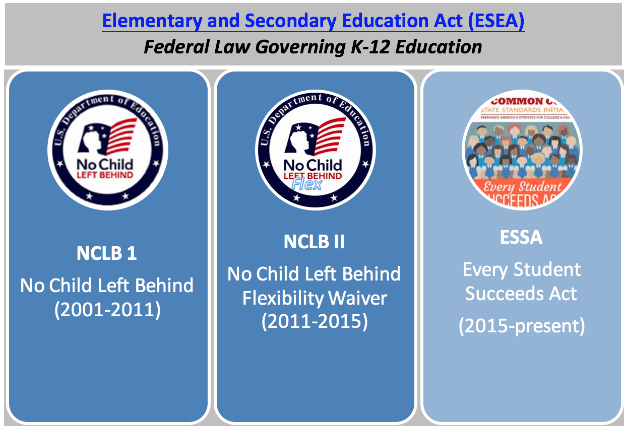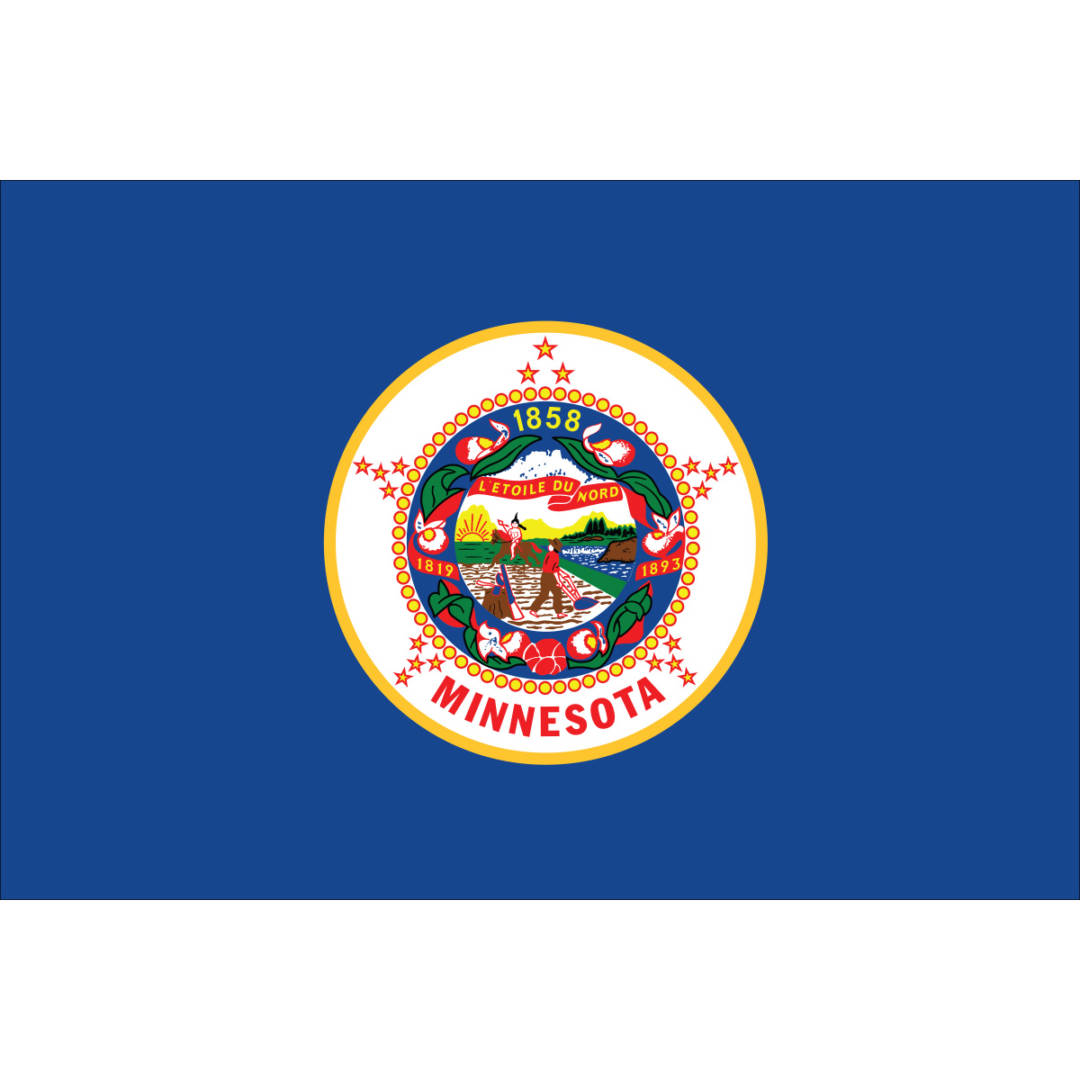Federal and states policies for ELs have only recently included ELs for state, district and school accountability. As we prepare for the implementation of Every Student Succeeds Act, a closer look at Minnesota and Indiana will examine the important role of state policies shaping federal policy.
As No Child Left Behind (NCLB, 2001) and the NCLB flexibility waivers (2012-2015) histories are behind us, we have learned important lessons in the Midwest of how federal and state laws have shaped the landscape for our Midwestern K-12 English Learners (ELs). NCLB (2001) was the first federal policy to explicitly include academic achievement and English learning in federal accountability. ELs were disaggregated as a subgroup and achievement could be readily seen comparative to other student subgroups, such as special education and children of color. But, NCLB came with an expectation of 100% of all student groups would be academically proficient by 2014, an expectation that was contested by states (Center on Education Policy, 2015; Kober & Riddle, 2012) with scholars arguing that it narrowed the curriculum to be too test-driven (Hout & Elliott, 2011).

The NCLB flexibility waivers (2012-2015) allowed a reprieve from the unrealistic 100% goal by permitting innovation for states to develop differentiated accountability models that included growth models versus a simple pass or fail on standardized state tests. In turn, we could examine the academic progress of our ELs diminishing penalties to districts for lack of academic attainment as ELs are simultaneously learning English and content (see Table 1 and Table 2). Growth models often use the term super subgroup or lowest performing group, privileging examination of growth patterns of the lowest performing students based on one year to the next, versus student characteristics, such as EL.
Table 1 Minnesota’s NCLB I and NCLB II Accountability Policies
| NCLB 2001-2012 (NCLB 1) | NCLB 2012-2015 (NCLB II) |
| Proficiency: Attainment percentage on state standardized test of English and Math by student subgroup (race, socioeconomic status, special education, EL) Schools judged by number of subgroups making performance benchmarks |
Proficiency: Attainment percentage on state standardized test of English and Math by student subgroup (race, socioeconomic status, special education, EL).Growth: Progress compared between two years of testing on standardized test of English and math by group
Growth gap reduction: Reducing disparities for student subgroups by race, socioeconomic status, special education and EL with higher performing subgroups. Graduation rate: Percentage of students on target for graduating in grades 9-12 Schools judged by percentage of growth by proficiency, growth, growth gap reduction and graduation rate to calculate a report card grade |
Table 2 Indiana’s NCLB I and NCLB II Accountability Policies
| NCLB 2001-2012 (NCLB I) | NCLB 2012-2015 (NCLB II) |
| Proficiency: Attainment percentage on state standardized test of English and Math by student subgroup (race, socioeconomic status, special education, EL)Schools judged by number of subgroups making performance benchmarks | Growth: Progress compared between two consecutive years of testing on standardized test of English and math by growth quadrants
Schools judged by percentage of growth by each quadrant with the outcome of a school and district grade |
Tables 1 and 2 adapted from Burke, DePalma, Ginther, Morita-Mullaney, and Young (2014); Morita-Mullaney (in press) and Burke, Morita-Mullaney, and Singh (2016)
To be eligible for the waiver, states had to have differentiated accountability models, but they also had to address three other areas:
- Implement College and Career Readiness standards;
- Implement innovative and differentiated accountability models (Table 1);
- Implement educator evaluation for effectiveness and
- Reducing undue administrative burden
(U.S. Department of Education, 2011)
While some may argue that progress has been achieved during NCLB (NCLB I) and the NCLB flexibility waivers (NCLB II), particular omissions and oversights of ELs persisted during NCLB II. Growth models of achievement had various inclusions of ELs that diminished consideration of their distinct language learning needs. This article discusses our lessons learned during the NCLB II or the NCLB flexibility period for our ELs and poses important considerations as we shape the upcoming federal Every Student Succeeds Act (ESSA, 2015) and related state policies in our Midwestern schools.
We review federal and state policy documents during the NCLB II (NCLB flexibility waiver), in Minnesota and Indiana. A focus on the Midwest is important as they are lower density EL states, but are considered two of the more rapidly growing EL states in the US (Migrant Policy Institute, 2010). We ask this central research question:
How do the Minnesota and Indiana’s NCLB flexibility waivers and state educational laws discuss English Learners (ELs)?
Literature Review
Literature on the NCLB II is limited given its short duration. This review will examine federal educational policies and how ELs are included. Secondly, the relationship between federal and state laws will be discussed.
EL Omissions and Inconsistencies
Historic federal educational policies within the Elementary and Secondary Education Act (ESEA) in the US have had limited to no inclusion of ELs (Bunch, 2011; Short, 2000) rendering EL decision making to the state and/or local districts. These omissions assume that ELs part of the greater populace, thus driving policies to be created at the school level that promoted or inhibited the educational needs and rights of ELs. Dissatisfied with the lack of discussion of ELs in the ESEA reauthorization of the Improving America School’s Act (1994), the international organization of Teachers of English to Speakers of Other Languages (TESOL) developed English language proficiency standards (TESOL, 1997), which preceded Minnesota and Indiana’s use of the English language proficiency standards of WIDA¹. These TESOL standards still largely support teacher education programs of EL certification in our universities (Fenner & Kuhlman, 2012).
Scholars also argue that lack of policy leads to language program models that restrict access to students’ native languages (Menken & Solorza, 2014a, 2014b). NCLB I and NCLB II allow students’ native languages within instruction, but inclining school accountability with aggressive standardized testing often drives English-only instructional provisions. Deep ideologies persist that English-only language programs have the most altruistic effects on academic achievement (Menken, 2008), even though there is substantive research to suggest that bilingual education has a superior impact on ELs language learning and academic achievement over time (Thomas & Collier, 1997; Thomas & Collier, 2002; Umansky & Reardon, 2014).
While the federal law of NCLB I and II enhanced the presence of ELs within federal educational policy by requiring their academic achievement, Title I Annual Measurable Objectives (AMOs) and their English learning progress and attainment, Title III Annual Measurable Achievement Objectives (AMAOs), created a united front of accountability for states, variations still persist. For example, identification of ELs upon enrollment uses a home language survey, asking questions about student and family language use, but surveys vary by state (Goldenberg & Rutherford-Quach, 2012). English language learning trajectories both for pacing (how fast) and the percentage reclassified as fluent English proficient (exited) varies by state with each working with different instruments and setting their own cut scores. These are just two examples of how federal policies are interpreted and practiced differently by state.
State and Federal Policy as One?
Educational laws are often conceived as hierarchical with laws made at the federal level and passed down for state implementation and onward to our districts and classrooms. Language policy scholars in education demonstrate that state laws and policies actually have a more imminent impact on our local district practices for ELs (Lillie & Moore, 2014; Moore, 2014). Gandara and Orfield (2012) and Arias and Faltis (2012) track the restrictive state policies in Arizona and how they have led to segregated language classrooms. Because NCLB II was an effort to decentralize the role of the federal government in education, examples like Arizona’s demonstrate the negative impacts of decentralization. Orfield (2006) critiqued the discourse and practice of flexibility, yielding to state rights, stating that laws should be “intelligible and predictable” and that “the [NCLB] policy is essentially a product of negotiation, of power and discretion, not law” (p. 7). Pompa (2016) asserts that federal laws have long protected the rights of ELs, when state laws have fallen short, pointing to shortcomings of decentralization to the states.
Analysis
To examine the variation that Orfield (2006) critiques and that Gandara and Orfield (2012), Lillie and Moore (2014) and Arias and Faltis (2012) research, we investigate Minnesota and Indiana and how they implemented
their NCLB flexibility waivers for ELs.
Minnesota Accountability Analysis
Minnesota’s federal NCLB flexibility waiver was approved in 2012 and amended in 2014 with EL discussion is woven throughout the document addressing academic standards, alignment between academic and English language proficiency standards (WIDA) and teacher professional standards. Specific discussion about the newly adopted academic standards, the Common Core State Standards (CCSS) and how the Minnesota Department of Education will work with WestEd to ensure a rigorous alignment are discussed in detail. Different types of EL professional development for all educators are identified including content on WIDA standards and alignment between WIDA and CCSS. Teacher evaluation for EL teachers is detailed as being “qualitatively different” and that a one-year study to pilot different models before establishing a expectations was needed (Minnesota Department of Education, 2014, p. 159). For accountability for schools and districts, the growth model is also discussed at length with the involvement of a stakeholder group that reworked through different accountability models before approval.
Minnesota’s growth model, referenced as the Multiple Measurements Rating (MMR) in the NCLB flexibility waiver is discussed in granular detail and includes multiple mechanisms for assessing educator effectiveness and school quality including proficiency (performance), growth, growth gap reduction and graduation rate (Minnesota Department of Education, 2012b). While growth of ELs is central, overall performance and how achievement gaps are being reduced over time are also included in school and teacher accountability.
Throughout the Minnesota NCLB waiver document, consistent references to Minnesota state law are made, demonstrating that EL content was conceptualized prior to writing the waiver. In addition to waiver content, Minnesota state statute has a robust inclusion and discussion of ELs in accountability. Minnesota also has a long history of discussing ELs throughout all Minnesota statute, beginning in 1990 with the inclusion of the English Language Learner Act (1990, 1998). In 2014, the Learning English for Academic Proficiency and Success (LEAPS) Act was passed, the most comprehensive legislation in the history of Minnesota, focusing not only on English language proficiency but also on bi- or multilingual skills development (Minnesota Session Law, 2014). The law has specific provisions and descriptions for students with interrupted formal schooling (SLIFE) and differentiated accountability for them (124D.59, Subd. 2a). Further, the policies specific to ELs are integrated throughout Minnesota statute including early childhood, curriculum and instruction, higher education, adult education, and teacher licensing (MN§122A.18, Expiration and Renewal, Subd. 4(b)
Indiana Accountability Analysis
In review of Indiana’s federal NCLB flexibility waiver approved in 2012 and amended and extended in 2013 by the US Department of Education (USDE) discussion of ELs is slim. Mention of adopting new English language proficiency standards are denoted as well as hiring a strong EL director at the Indiana Department of Education. Discussion of EL inclusion in the super-subgroup states that more instructional attention will be offered to ELs as they are more likely to fall into the super-subgroup and under the old subgroup model (Adequate Yearly Progress), only 19% of Indiana districts would be held accountable (Indiana Department of Education, 2012, p. 63). The Indiana waiver states that Indiana laws and the NCLB waiver are “merged” making the federal and state law synonymous (Indiana Department of Education, 2011, 2012, 2014) with a grade of A-F being given to schools and districts based on growth performance with particular attention on the super subgroup.
Indiana’s NCLB waiver is connected to Indiana’s Public Law 221 (2011), which is the school accountability law. EL references remain scant. First, ELs are operationally defined as Limited English proficient, a subtractive term that decentralizes their bilingual assets (García, 2009). Second, provisions of an Individual Learning Plan directs the instructional provisions for ELs and lastly, four references to their inclusion or exclusion in standardized testing of English language arts and Mathematics.
Cross-Analysis of Indiana and Minnesota’s Policies for ELs
There is no mention in Indiana PL 221 or the NCLB flexibility waiver of English language learning gains or academic achievements as a subgroup still required under federal Title III AMAOs. This omission lead schools to de-emphasize or omit attention to English learning gains and academic achievement by subgroup, thereby ignoring their needs and rights (Burke, DePalma, et al., 2014; Burke, Morita-Mullaney, & Singh, 2014; Burke et al., 2016). Despite Minnesota and Indiana having a shared Midwestern geography, state laws for ELs are exponentially different.
Table 3 Minnesota and Indiana Accountability Comparisons
| NCLB flexibility waiver (NCLB II) | Minnesota NCLB flexibility waiver | Minnesota state policy | Indiana NCLB flexibility waiver | Indiana state policy |
| Career and College readiness for all studentsAcademic standards & related standardized exams</td > | Common Core State Standards for ELA only | World’s Best Work Force Minnesota Statutes, section 120B.11 | Indiana College and Career Readiness Standards & Indiana State Test of Educational Progress (ISTEP+) | Public Law 221 (2011) |
| Differentiated recognition, accountability and support systemsGrowth models | Multiple Measurements Rating (MMR) – Proficiency, growth, growth gap reduction, graduation rate for a school grade | Minnesota Statutes 2014, section 120B.35 | A-F Model – Student growth by super-subgroup | Public Law 221 (2011) |
| Supporting effective instruction and leadershipEducator evaluation | District-approved evaluation or MDE plan if none adopted at district | Evaluation of principals Minnesota Statute, §123B.147, Evaluation of teachers Minnesota Statute,§122A.40, Subd. 8, and §122A.41, Subd. 5 | RISE Evaluation | Public Law 221 (2011) |
| Reducing undue administrative burdens | State policy driving federal policycreated consecutively | State statutes and laws inform NCLB flexibility waiver | Merging of state policy with federal policycreated concurrently | PL 221 = NCLB flexibility waiver |
While exclusion of ELs has long been critiqued by language policy scholars as nullifying the rights of ELs (Wiley, 2014), it also results in generic instructional provisions for ELs without any research to support such approaches (Morita-Mullaney, 2014). While Minnesota can be congratulated for their robust inclusion of ELs in state and federal waiver applications in 2012 and again in 2014, the procedure for inclusion is extremely complex. Formulas of calculating a school and district’s score are multi-faceted, making it difficult for school leaders to juggle the four accountability areas of proficiency, growth, growth gap reduction and graduation rate concurrently, potentially materializing into less attention to ELs. While Indiana’s discussion of EL content is scant in the waiver and state law, the outcome is dismissal of ELs’ needs (Morita-Mullaney, in press). Regardless of whether a state waiver focuses deeply or scarcely on ELs, the outcome still points to oversight. In Indiana, the NCLB waiver policy makes ELs invisible. In Minnesota, a sea of complicated accountability metrics makes the visibility of ELs clouded and obscured.
So, What’s My Role?
As the rule-making for ESSA is forthcoming and states are meeting with advisory teams to strategize on implementation, it is important to be attentive to the role that states now play in the creation of federal policy. ESSA promotes more state choice, making it incumbent upon Minnesota and Indiana to be detailed about EL needs and rights. Content needs to be robust, but coherent and intelligible. Further, decentralization now offers a generative form of policy making, offering us a newer and different opportunity to advocate for our Minnesota and Indiana ELs. Change can happen from the classrooms and our communities and not just the top. Generative change is already evident as Minnesota and Indiana’s grassroots advocacy has resulted in the passing of the Seal of Biliteracy for graduates with high degrees of bilingual language proficiency (2015), grooving pathways to honor the bilingual assets of our students whose linguistic repertoires include more than just English.
If you are a teacher or principal, be engaged and be a policy maker instead of a policy recipient. Decentralization within ESSA offers states and districts room for creativity and you can be a part of shaping policy. Effective teacher advocacy requires staying up-to-date on the recent developments in research and policy (Herrera & Murry, 2016). Understanding ESSA and its implications for ELLs provides an opportunity for teachers to voice their concerns and speak up on behalf of ELLs. We encourage you to ask questions in various public and social media forums such as education blogs, create White papers with your local EL educator teams and remain involved with your state chapters of TESOL, MinneTESOL and INTESOL.
If you are a principal, be engaged with your local and state school leadership associations, such as the Minnesota Association of School Administrators and the Indiana Association of School Principals and partner with state TESOL affiliates so ELs are not tangential, but central in our policy making, interpretation and implementation.
Useful Readings and Web Resources for Teachers
Crawford, J. (2016). Language Policy Website and Emporium.
Westerlund, R. (2016). Reclaiming the Language for Social Justice.
Wright, W. (2016). Every Student Succeeds Act and English Language Learners.
References
Arias, M. B., & Faltis, C. (2012). Implementing educational language policy in Arizona legal, historical and current practices in SEI. Buffalo, NY: Multilingual Matters.
Bunch, M. B. (2011). Testing English language learners under No Child Left Behind. Language Testing, 28(3), 323-341. doi: 10.1177/0265532211404186
Burke, A. M., DePalma, G., Ginther, A., Morita-Mullaney, T., & Young, J. W. (2014). Accountability Lessons for Indiana Schools Serving English Learners. Indiana Teachers of English to Speakers of Other Languages, 11(1), 10-24.
Burke, A. M., Morita-Mullaney, T., & Singh, M. (2014). Indiana English Language Learner Academic and English Proficiency Performance: A Longitudinal Study–A White Paper. Indianapolis, IN.
Burke, A. M., Morita-Mullaney, T., & Singh, M. (2016). Indiana Emergent Bilingual Student Time to Reclassification: A Survival Analysis. American Educational Research Journal, 53(5), 1310-1342. doi: 10.3102/0002831216667481
Center on Education Policy. (2015). Federal Education Programs: NCLB/ESEA Waivers. Retrieved November 1, 2015, from http://www.cep-dc.org/index.cfm?DocumentSubTopicID=48
Every Student Succeeds Act, Public Law 114-95 Stat. (2015 December 10, 2015).
Fenner, D. S., & Kuhlman, N. A. (2012). Preparing teachers of English language learners : practical applications of the Pre K-12 TESOL professional standards. Alexandria, VA: TESOL International Association.
Gandara, P., & Orfield, G. (2012). Why Arizona matters: the historical, legal and political contexts of Arizona’s instructional policies and linguistic hegemony. Language Policy, 11. doi: 10.1007/s10993-011-9227-2
García, O. (2009). Bilingual Education in the 21st Century: A Global Perspective. Malden, MA: Wiley-Blackwell.
Goldenberg, C., & Rutherford-Quach, S. (2012). The Arizona home language survey: The under-identification of students for English language services. Language Policy, 11(1), 21-30.
Hout, M., & Elliott, S. (Eds.). (2011). Incentives and Test-Based Accountability in Education. Washington, DC.
Indiana Department of Education. (2011). ESEA Flexibility Waiver Application. Indianapolis, IN.
Indiana Department of Education. (2012). ESEA flexibility request. Submitted to the U.S. Department of Education Retrieved November 1, 2013, from http://www2.ed.gov/policy/eseaflex/approved-requests/in.pdf
Indiana Department of Education. (2014). ESEA flexibility request. Submitted to the U.S. Department of Education Retrieved November 1, 2014, from http://www2.ed.gov/policy/elsec/guid/esea-flexibility/map/in.html
Kober, N., & Riddle, W. (2012). Accountability Issues to Watch under NCLB Waivers. In Center on Education Policy (Ed.), (pp. 1-11). Washington, DC: The George Washington University.
Lillie, K. E., & Moore, S. C. K. (2014). SEI in Arizona: Bastion for states’ rights. In S. C. K. Moore (Ed.), Language policy process and consequences: Arizona case studies (pp. 1-27). Clevedon: Multilingual Matters.
Menken, K. (2008). English learners left behind : standardized testing as language policy. Buffalo, NY: Multilingual Matters Ltd.
Menken, K., & Solorza, C. (2014a). No Child Left Bilingual: accountability and the elimination of bilingual education programs in New York city schools. Educational Policy, 28(1), 96-125. doi: 10.1177/0895904812468228
Menken, K., & Solorza, C. (2014b). Principals as linchpins in bilingual education: the need for prepared school leaders. International Journal of Bilingual Education and Bilingualism, 1-22. doi: 10.1080/13670050.2014.937390
Migrant Policy Institute. (2010). ELL information center: Fact sheet series (Vol. 1). Washington, DC.
Minnesota Department of Education. (2012a). ESEA flexibility request: Minnesota. Retrieved May 15, 2016, from http://www2.ed.gov/policy/eseaflex/mn.pdf
Minnesota Department of Education. (2012b). Multiple Measures Rating (MMR). 2016, from http://education.state.mn.us/MDE/SchSup/ESEAFlex/MMR/index.html
Minnesota Department of Education. (2014). ESEA flexibility renewal: Minnesota. Retrieved May 15, 2016, from http://www2.ed.gov/policy/eseaflex/approved-requests/mn2extreq82014.doc
Moore, S. C. (2014). Language Policy Processes and Consequences: Arizona Case Studies Tonawanda, NY: Multilingual Matters.
Morita-Mullaney, T. (2014). In/Exclusion of English Learners in longitudinal research: a historical review of Indiana’s s
chool accountability for English Learners. Indiana Teachers of English to Speakers of Other Languages, 11(1), 61-84.
Morita-Mullaney, T. (in press). Borrowing legitimacy as English Learner (EL) Leaders: Indiana’s 14-year history with English language proficiency standards. Language Testing.
No Child Left Behind, Pub.L. 107–110, 115 Stat. 1425 (2001).
Orfield, G. (2006). Foreword of The Unraveling of No Child Left Behind: How Negotiated Changes Transform the Law. In G. L. Sunderman (Ed.), Unraveling No Child Left Behind: How Negotiated Changes Transform the Law. Cambridge, MA: The Civil Rights Project at Harvard University.
Pompa, D. (2016). New education law puts more pressure on states to serve English learners. Retrieved from https://edsource.org/2016/new-education-law-puts-more-pressure-on-states-to-serve-english-learners/92811.
Public Law 221, Indiana Code, 511 IAC Stat. (2011).
Short, D. (2000). The ESL standards: bridging the academic gap for English language learners. Washington, DC: ERIC Clearinghouse on Languages and Linguistics.
TESOL. (1997). ESL standards for pre-K–12 students. Alexandria, VA: Author.
Thomas, W. P., & Collier, V. (1997). School effectiveness for language minority students.
Washington, DC: National Clearinghouse for Bilingual Education.
Thomas, W. P., & Collier, V. P. (2002). A national study of school effectiveness for language minority students’ long-term academic achievement (pp. 351). Santa Cruz, CA: Center for Research on Education, Diversity and Excellence.
U.S. Department of Education. (2011). The opportunity of the ESEA flexibility: protecting students and supporting educational solutions. Washington, DC: U.S. Department of Education.
U.S. Department of Education. (2014). Laws and guidance: ESEA flexibility. from http://www2.ed.gov/policy/elsec/guid/esea-flexibility/index.html
Umansky, I., & Reardon, S. (2014). Bilingual, Dual Immersion, and English Immersion Classrooms in Reclassification Patterns Among Latino English Learner Students. American Educational Research Journal, XX(XX), 1-34. doi: 10.3102/0002831214545110
WIDA. (2016). Mission and WIDA story. from https://www.wida.us/aboutus/mission.aspx
Wiley, T. G. (2014). Consequences of Nullification. In S. C. K. Moore (Ed.), Language policy process and consequences: Arizona case studies (pp. 156-164). Clevedon: Multilingual Matters.
NOTES:
- In 2002 an Enhanced Assessment Grant provided initial funding for the organization that would become WIDA. Three states were involved in the grant: Wisconsin (WI), Delaware (D), and Arkansas (A), so the acronym WIDA was chosen for the name. At the last minute, however, Arkansas dropped out, and World-class Instructional Design and Assessment was created to fit the acronym. As WIDA grew, however, the original name no longer adequately described its mission. Recently WIDA decided to stop using the acronym definition. Now WIDA just means WIDA (WIDA, 2016).









